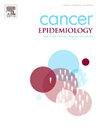Temporal trends and spatial distribution of prostate cancer incidence and mortality in a northeastern Brazilian state
IF 2.3
3区 医学
Q3 ONCOLOGY
引用次数: 0
Abstract
Background
Prostate cancer incidence and mortality exhibit regional variation often linked to disparities in healthcare access and disease management. This study aimed to analyze temporal trends and spatial distribution of prostate cancer incidence (1996–2017) and mortality (1996–2022) in Sergipe, Brazil, to support targeted cancer control strategies.
Methods
We analyzed prostate cancer data from the Aracaju Cancer Registry and the Mortality Information System. Age-standardized incidence and mortality rates were calculated using the World Standard Population. Joinpoint regression estimated Annual Percent Change (APC) and Average Annual Percent Change (AAPC) to assess trends. The Mortality-to-Incidence Ratio (MIR) and its complement (1–MIR) were used as proxies for survival. Spatial distribution was examined using Empirical Bayesian Kriging and local empirical Bayes smoothing in QGIS and TerraView.
Results
Between 1996 and 2017, 10,133 incident prostate cancer cases were recorded. Incidence increased until 2007 (APC=11.9 %; p < 0.001), then declined (APC=–2.0 %; p = 0.027, with peaks in men aged ≥55. Mortality increased from 1996 to 2007 (APC=12.2 %; p < 0.001) and subsequently stabilised between 2007 and 2022 (APC=–0.8 %; p = 0.228), resulting in an overall AAPC of 2.4 % (p = 0.002) for the entire study period. By age group, mortality rose among men ≥ 75 years (AAPC=3.2 %; p = 0.001) but declined in those aged 15–54 (AAPC=–2.4 %; p = 0.004). The MIR remained flat over time, but estimated survival dropped substantially among men aged ≥ 75 years, from 63 % to 38 %. Spatial analysis revealed higher incidence in central/coastal municipalities, while elevated mortality clustered in southern/coastal areas.
Conclusions
Despite improvements in incidence rates, prostate cancer remains a significant burden in Sergipe, with persistent regional disparities in outcomes. Spatial and temporal analyses highlight the need for targeted public health interventions to improve early detection and access to care, especially in areas of high social vulnerability and among older men.
巴西东北部一个州前列腺癌发病率和死亡率的时间趋势和空间分布
背景:前列腺癌的发病率和死亡率表现出区域差异,通常与医疗保健和疾病管理的差异有关。本研究旨在分析巴西Sergipe市前列腺癌发病率(1996-2017年)和死亡率(1996-2022年)的时间趋势和空间分布,为有针对性的癌症控制策略提供支持。方法我们分析来自阿拉卡朱癌症登记处和死亡率信息系统的前列腺癌数据。使用世界标准人口计算年龄标准化发病率和死亡率。联合点回归估计年变化百分比(APC)和平均年变化百分比(AAPC)来评估趋势。使用死亡率-发病率比(MIR)及其补体(1-MIR)作为生存指标。利用经验贝叶斯Kriging和局部经验贝叶斯平滑对QGIS和TerraView中的空间分布进行了检验。结果1996年至2017年,共记录了10133例前列腺癌病例。发病率上升至2007年(APC=11.9 %;p <; 0.001),然后下降(APC= -2.0 %;p = 0.027,年龄≥55岁的男性发病率最高。死亡率从1996增加到2007 (APC % = 12.2;p & lt; 0.001),随后企稳在2007年和2022年之间(APC % = -0.8;p = 0.228),导致整体AAPC 2.4 % (p = 0.002)为整个研究期间。按年龄组划分,≥ 75岁男性死亡率上升(AAPC=3.2 %;p = 0.001),15-54岁男性死亡率下降(AAPC= -2.4 %;p = 0.004)。随着时间的推移,MIR保持平稳,但≥ 75岁男性的估计生存率大幅下降,从63% %降至38% %。空间分析显示,中部/沿海城市发病率较高,而死亡率升高集中在南部/沿海地区。结论:尽管发病率有所改善,但前列腺癌仍然是Sergipe地区的一个重大负担,并且在结果上存在持续的地区差异。空间和时间分析突出表明,需要有针对性的公共卫生干预措施,以改善早期发现和获得护理的机会,特别是在社会脆弱性高的地区和老年男子中。
本文章由计算机程序翻译,如有差异,请以英文原文为准。
求助全文
约1分钟内获得全文
求助全文
来源期刊

Cancer Epidemiology
医学-肿瘤学
CiteScore
4.50
自引率
3.80%
发文量
200
审稿时长
39 days
期刊介绍:
Cancer Epidemiology is dedicated to increasing understanding about cancer causes, prevention and control. The scope of the journal embraces all aspects of cancer epidemiology including:
• Descriptive epidemiology
• Studies of risk factors for disease initiation, development and prognosis
• Screening and early detection
• Prevention and control
• Methodological issues
The journal publishes original research articles (full length and short reports), systematic reviews and meta-analyses, editorials, commentaries and letters to the editor commenting on previously published research.
 求助内容:
求助内容: 应助结果提醒方式:
应助结果提醒方式:


